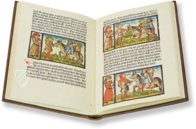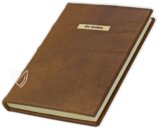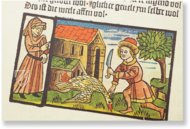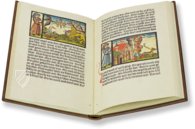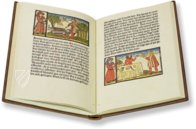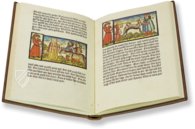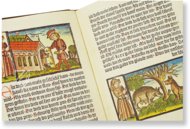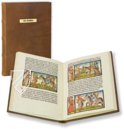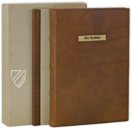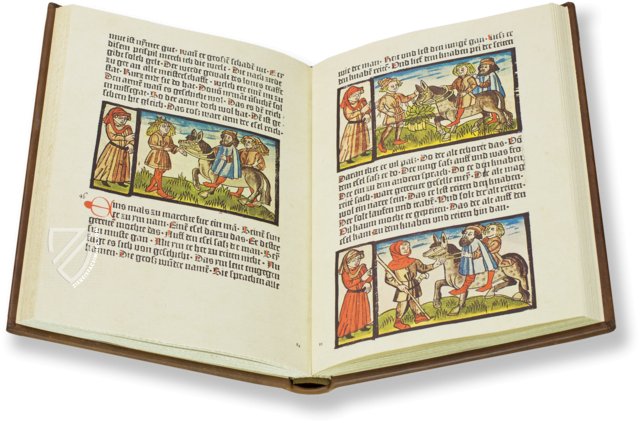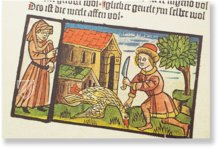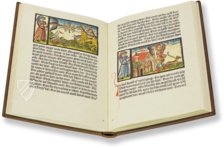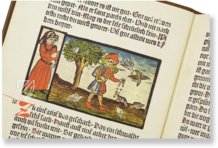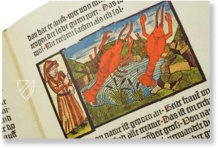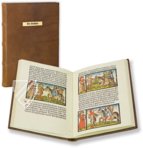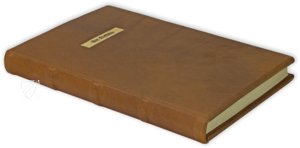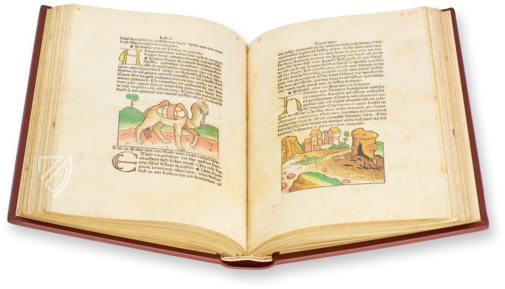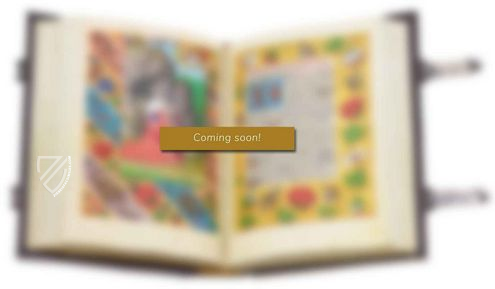Boner: The Gemstone
(under 1,000€)
The collection of fables with the title The Gemstone by the Bern Dominican Ulrich Boner was a beloved moralist text of the 14th century. Transmitted in a variety of editions, the specimen from the Wolfenbüttel represents a preeminent anomaly, for one thing, it is probably the first work printed with moveable type in the German language, on the other hand, the earliest example of a printed work illustrated using woodcuts. This entertaining and also instructive text is illustrated with lovingly designed images.
Boner: The Gemstone
The collection of fables with the title The Gemstone by the Bern Dominican Ulrich Boner was a beloved moralist text of the 14th century. Transmitted in a variety of editions, the specimen from the Wolfenbüttel represents a preeminent anomaly, for one thing, it is probably the first work printed with moveable type in the German language, on the other hand, the earliest example of a printed work illustrated using woodcuts. This entertaining and also instructive text is illustrated with lovingly designed images.
Aesopian Fables in Swiss Vernacular
Playful monkeys leap through the picture, a sly cat steals birds from a nest, animals and humans come together in harmony. The collection of fables by Ulrich Boner combines entertaining stories with general moral instruction. The fables are illustrated in beautifully colored woodcuts and make the lectures of the book more enjoyable as a result. Originating in Switzerland in the first half of the 14th century, Boner, who was identifiable in Bern during this time, assembled fables from Latin sources in his text underpinned by the example of Aesop. The text is written in the Old Swiss-German dialect, nevertheless is easily understandable and readable.
Colored Woodcuts with Instructive Content
Among its numerous other treasures from the world of book art and early printed books, the Duke August Library in Wolfenbüttel houses a special specimen of Boner’s The Gemstone. The specimen, printed in 1461, is the first of the beloved and widely circulated work to be published. It was printed in the Bamberg printing shop of Albrecht Pfister and was decorated with numerous artistic woodcuts as an additional distinctive feature. The woodcuts are lovingly colored and inserted into their respective position in the text. Set in a black border, the pictorial scenes are always accompanied by a man dressed in red with a turban-like head covering, who refers to the pictures with a pointing finger. In this way, the meaningfulness of the moralist aspect is stressed in the illustrations.
A Milestone of Book Art
The Wolfenbüttel Edition of Boner’s The Gemstone represents the beginning of an important development. As the presumptive first book printed with moveable type, it preempted the following revolution in book production. The use of moveable type for book printing, made famous by Johannes Gutenberg, arose after 1450, about a decade before the emergence of the Bamberg edition of The Gemstone in 1461. It is for this reason that the book represents a milestone of book printing and takes a unique place in the history of book art.
Codicology
- Alternative Titles
- Boner: Der Edelstein
- Size / Format
- 176 pages / 28.3 × 18.3 cm
- Origin
- Germany
- Date
- 1461
- Epochs
- Style
- Genre
- Language
- Illustrations
- 101 colored woodcuts
- Content
- Collection of 100 fables
- Artist / School
- Ulrich Boner (author)
Albrecht Pfister (printer)
Boner: The Gemstone
The Swallow and the Other Birds
A swallow and some other birds were picking through the soil for food one day while a farmer was sowing some hemp seeds in a field. “Beware that man and be careful to pick up all of the seeds or you will regret it someday,” said the swallow, but the other birds paid no attention to this warning. After the hemp grew, the farmer made cords from it and then made a net from the cords, which he used to catch many of the birds. The moral of the story is to destroy the seed of evil, or it will grow up to your ruin.
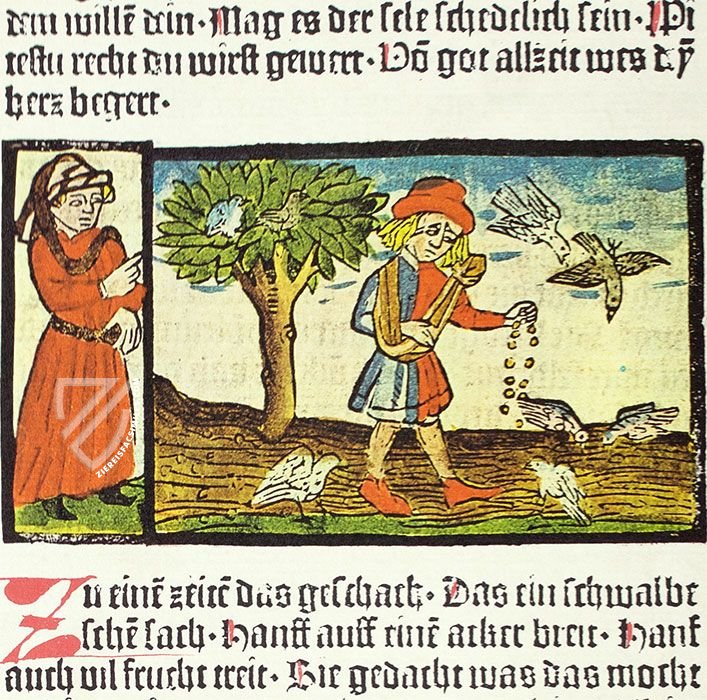
Boner: The Gemstone
Father, Son, and Donkey
A father rides a donkey as his son walks alongside when a passerby laments that the poor boy with his short legs can barely keep up while the father lazily rides the donkey, so they switch. The next passerby comments how impudent the son must be to make his poor old father walk, so they both ride the donkey. A third passerby scolds them for overworking the beast and both dismount before another makes fun of them for walking, so they carry it on a pole, earning them yet more ridicule.
The moral of this fable, which has appeared in various forms around the world since antiquity, is to trust your own judgment because you will never please everyone. It is a classic example of a polylemma: a situation – a dilemma specifically – in which there are two or more options to choose from, but none of which is preferable.

#1 Boner: Der Edelstein
Language: German
(under 1,000€)
- Treatises / Secular Books
- Apocalypses / Beatus
- Astronomy / Astrology
- Bestiaries
- Bibles / Gospels
- Chronicles / History / Law
- Geography / Maps
- Saints' Lives
- Islam / Oriental
- Judaism / Hebrew
- Single Leaf Collections
- Leonardo da Vinci
- Literature / Poetry
- Liturgical Manuscripts
- Medicine / Botany / Alchemy
- Music
- Mythology / Prophecies
- Psalters
- Other Religious Books
- Games / Hunting
- Private Devotion Books
- Other Genres
- Afghanistan
- Armenia
- Austria
- Belgium
- Colombia
- Croatia
- Cyprus
- Czech Republic
- Denmark
- Egypt
- Ethiopia
- France
- Germany
- Greece
- Hungary
- India
- Iran
- Iraq
- Israel
- Italy
- Japan
- Lebanon
- Luxembourg
- Mexico
- Morocco
- Netherlands
- Palestine
- Peru
- Poland
- Portugal
- Russia
- Serbia
- Spain
- Sri Lanka
- Sweden
- Switzerland
- Syria
- Turkey
- Ukraine
- United Kingdom
- United States
- Uzbekistan
- Aboca Museum
- Ajuntament de Valencia
- Akademie Verlag
- Akademische Druck- u. Verlagsanstalt (ADEVA)
- Aldo Ausilio Editore - Bottega d’Erasmo
- Alecto Historical Editions
- Alkuin Verlag
- Almqvist & Wiksell
- Amilcare Pizzi
- Andreas & Andreas Verlagsbuchhandlung
- Archa 90
- Archiv Verlag
- Archivi Edizioni
- Arnold Verlag
- ARS
- Ars Magna
- ArtCodex
- AyN Ediciones
- Azimuth Editions
- Badenia Verlag
- Bärenreiter-Verlag
- Belser Verlag
- Belser Verlag / WK Wertkontor
- Benziger Verlag
- Bernardinum Wydawnictwo
- BiblioGemma
- Biblioteca Apostolica Vaticana (Vaticanstadt, Vaticanstadt)
- Bibliotheca Palatina Faksimile Verlag
- Bibliotheca Rara
- Boydell & Brewer
- Bramante Edizioni
- Bredius Genootschap
- Brepols Publishers
- British Library
- C. Weckesser
- Caixa Catalunya
- Canesi
- CAPSA, Ars Scriptoria
- Caratzas Brothers, Publishers
- Carus Verlag
- Casamassima Libri
- Chavane Verlag
- Christian Brandstätter Verlag
- Circulo Cientifico
- Club Bibliófilo Versol
- Club du Livre
- CM Editores
- Collegium Graphicum
- Collezione Apocrifa Da Vinci
- Comissão Nacional para as Comemorações dos Descobrimentos Portugueses
- Coron Verlag
- Corvina
- CTHS
- D. S. Brewer
- Damon
- De Agostini/UTET
- De Nederlandsche Boekhandel
- De Schutter
- Deuschle & Stemmle
- Deutscher Verlag für Kunstwissenschaft
- DIAMM
- Droz
- E. Schreiber Graphische Kunstanstalten
- Ediciones Boreal
- Ediciones Grial
- Ediclube
- Edições Inapa
- Edilan
- Editalia
- Edition Deuschle
- Edition Georg Popp
- Edition Leipzig
- Edition Libri Illustri
- Editiones Reales Sitios S. L.
- Éditions de l'Oiseau Lyre
- Editions Medicina Rara
- Editorial Casariego
- Editorial Mintzoa
- Editrice Antenore
- Editrice Velar
- Edizioni Edison
- Egeria, S.L.
- Eikon Editores
- Electa
- Emery Walker Limited
- Enciclopèdia Catalana
- Eos-Verlag
- Ephesus Publishing
- Ernst Battenberg
- Eugrammia Press
- Extraordinary Editions
- Fackelverlag
- Facsimila Art & Edition
- Facsimile Editions Ltd.
- Facsimilia Art & Edition Ebert KG
- Faksimile Verlag
- Feuermann Verlag
- Folger Shakespeare Library
- Franco Cosimo Panini Editore
- Friedrich Wittig Verlag
- Fundación Hullera Vasco-Leonesa
- G. Braziller
- Gabriele Mazzotta Editore
- Gebr. Mann Verlag
- Gesellschaft für graphische Industrie
- Getty Research Institute
- Giovanni Domenico de Rossi
- Giunti Editore
- Graffiti
- Grafica European Center of Fine Arts
- Guido Pressler
- Guillermo Blazquez
- Gustav Kiepenheuer
- H. N. Abrams
- Harrassowitz
- Helikon
- Hendrickson Publishers
- Henning Oppermann
- Herder Verlag
- Hes & De Graaf Publishers
- Hoepli
- Holbein-Verlag
- Hortus Deliciarum
- Houghton Library
- Hugo Schmidt Verlag
- Idion Verlag
- Il Bulino, edizioni d'arte
- ILte
- Imago
- Insel Verlag
- Instituto Nacional de Antropología e Historia
- Istituto dell'Enciclopedia Italiana - Treccani
- Istituto Ellenico di Studi Bizantini e Postbizantini
- Istituto Geografico De Agostini
- Istituto Poligrafico e Zecca dello Stato
- Italarte Art Establishments
- J. Thorbecke
- Jan Thorbecke Verlag
- Johnson Reprint Corporation
- Josef Stocker
- Josef Stocker-Schmid
- Jugoslavija
- Karl W. Hiersemann
- Kasper Straube
- Kaydeda Ediciones
- Kindler Verlag / Coron Verlag
- Kodansha International Ltd.
- Konrad Kölbl Verlag
- Kurt Wolff Verlag
- La Liberia dello Stato
- La Linea Editrice
- La Meta Editore
- Lambert Schneider
- Landeskreditbank Baden-Württemberg
- Leo S. Olschki
- Les Incunables
- Library of Congress
- Libreria Musicale Italiana
- Lichtdruck
- Lito Immagine Editore
- Lumen Artis
- Lund Humphries
- M. Moleiro Editor
- Maison des Sciences de l'homme et de la société de Poitiers
- Manuscriptum
- Martinus Nijhoff
- Maruzen-Yushodo Co. Ltd.
- MASA
- McGraw-Hill
- Militos
- Millennium Liber
- Müller & Schindler
- Nahar and Steimatzky
- National Library of Wales
- Neri Pozza
- Nova Charta
- Oceanum Verlag
- Odeon
- Orbis Mediaevalis
- Orbis Pictus
- Österreichische Staatsdruckerei
- Oxford University Press
- Pageant Books
- Parzellers Buchverlag
- Patrimonio Ediciones
- Pattloch Verlag
- PIAF
- Pieper Verlag
- Plon-Nourrit et cie
- Prestel Verlag
- Princeton University Press
- Prisma Verlag
- Priuli & Verlucca, editori
- Pro Sport Verlag
- Propyläen Verlag
- Pytheas Books
- Quaternio Verlag Luzern
- Reales Sitios
- Recht-Verlag
- Reichert Verlag
- Reichsdruckerei
- Riehn & Reusch
- Roberto Vattori Editore
- Rosenkilde and Bagger
- Roxburghe Club
- Salerno Editrice
- Sarajevo Svjetlost
- Schöck ArtPrint Kft.
- Scolar Press
- Scrinium
- Scripta Maneant
- Scriptorium
- Siloé, arte y bibliofilia
- SISMEL - Edizioni del Galluzzo
- Sociedad Mexicana de Antropología
- Société des Bibliophiles & Iconophiles de Belgique
- Soncin Publishing
- Sorli Ediciones
- Stainer and Bell
- Studer
- Styria Verlag
- Sumptibus Pragopress
- Szegedi Tudomànyegyetem
- Taberna Libraria
- Tarshish Books
- Taschen
- Tempus Libri
- Testimonio Compañía Editorial
- Thames and Hudson
- The Clear Vue Publishing Partnership Limited
- The Facsimile Codex
- The Folio Society
- The Marquess of Normanby
- The Richard III and Yorkist History Trust
- Tip.Le.Co
- TouchArt
- TREC Publishing House
- TRI Publishing Co.
- Trident Editore
- Typis Regiae Officinae Polygraphicae
- Union Verlag Berlin
- Universidad de Granada
- University of California Press
- University of Chicago Press
- Urs Graf
- Vallecchi
- Van Wijnen
- VCH, Acta Humaniora
- VDI Verlag
- VEB Deutscher Verlag für Musik
- Verlag Anton Pustet / Andreas Verlag
- Verlag Bibliophile Drucke Josef Stocker
- Verlag der Münchner Drucke
- Verlag für Regionalgeschichte
- Verlag Styria
- Vicent Garcia Editores
- W. Turnowsky
- Waanders Printers
- Wiener Mechitharisten-Congregation (Wien, Österreich)
- Wissenschaftliche Buchgesellschaft
- Wydawnictwo Dolnoslaskie
- Xuntanza Editorial
- Zakład Narodowy
- Zollikofer AG




